If you run a local business and want more people to find you online then this guide is for you.
Local SEO in 2025 isn’t just about ranking; it’s about showing up where your customers are searching, earning their trust, and turning clicks into foot traffic or phone calls.
Whether you’re just getting started or want better results, these tips will help you grow smarter, faster, and more locally.
What Is Local SEO and Why It Matters in 2025
Local SEO is the process of improving your business’s visibility in location-based searches.

When someone nearby types “coffee shop near me” or “emergency electrician in Swindon,” Google shows results based on location, reviews, and relevance. And you can help google to understand these factors by implementing proper local SEO optimization
For local business owners, this means your online presence isn’t just a website anymore, it’s your digital storefront. If you’re not showing up on the map, someone else is.
In 2025, competition is massive. People use search engines more than anything, and most customers won’t scroll past the first few results. That’s why ranking high for your area isn’t just nice, it’s necessary.
It doesn’t matter you’re running a bakery, salon, repair shop, or law firm, local SEO can bring you the right foot traffic or phone calls without spending a fortune on ads.
What’s New in Local SEO for 2025
Local SEO has changed over the years and Google continuously updating it’s algorithm to provide the best results to their users. In 2025, if you want to dominate your local search then you must follow one golden rule which is to prioritize your user first and search engine second.
Search engines are becoming smarter. Instead of just matching keywords, they now understands search intent more clearly. It can tell when someone wants directions, needs to call a business, or just wants to read reviews, and it ranks pages based on those signals.
You’ll also notice more zero-click searches, where answers appear directly in search results. That means if your business isn’t optimized to show up in those features (like map packs or featured snippets), you’re missing out lots of potential leads for sure.
Voice search is on the rise too. People are asking things like, “Where’s the best pizza place open right now?” If your content doesn’t match how real people talk, your site may remain invisible.
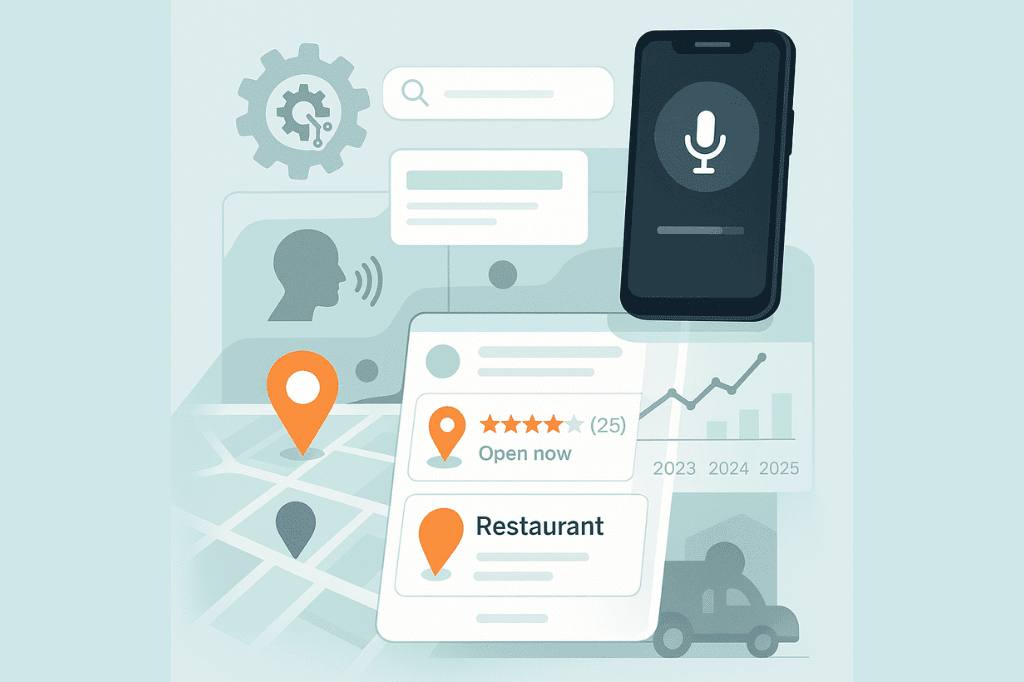
So, To stay ahead, your business needs more than just keywords based strategy instead You need relevance, accuracy, and user focused content. We’ll show you how in the next sections.
Common SEO Mistakes Local Business Owners Still Make
Many local business owners try SEO, but not all get results.
Why?
Because small missteps can hinder big wins.
Let’s go over a few of the most common mistakes we still see in 2025.
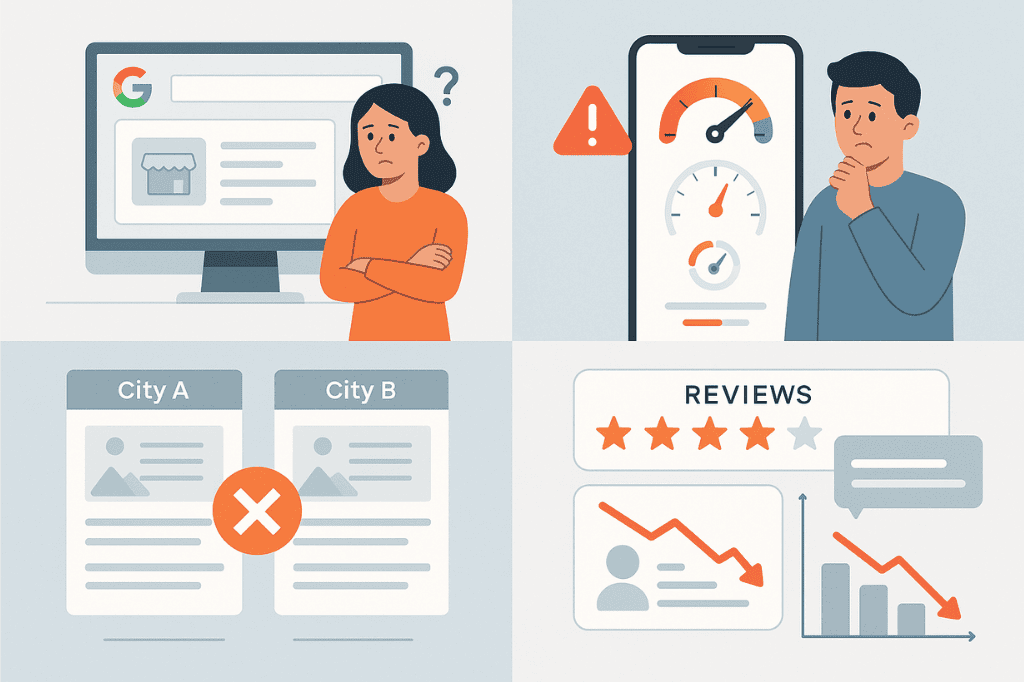
1. Ignoring Google Business Profile (GBP):
Some businesses still haven’t claimed or updated their GBP profile (Previously Google My Business). This is so important one for local visibility. Because without this, you won’t appear in local map results, even if your website is strong.
2. One-page websites with no location signals:
This is another major issues why your website is invisible. If your website doesn’t mention your service areas clearly or uses vague content, Google won’t know where to rank you.
3. Duplicate or thin content across multiple pages:
Creating the same service page (or location page) for different cities without changing the content won’t help today. In fact, it might hurt your rankings and causes penalties.
4. Forgetting mobile experience:
Around half of the searches are came from mobile users and it’s increasing insanely. And if you talk about local searches then the number is more higher. Most local searches happen on phones. If your site loads slowly or buttons are hard to click, users will bounce, and it passes a poor signal to Google.
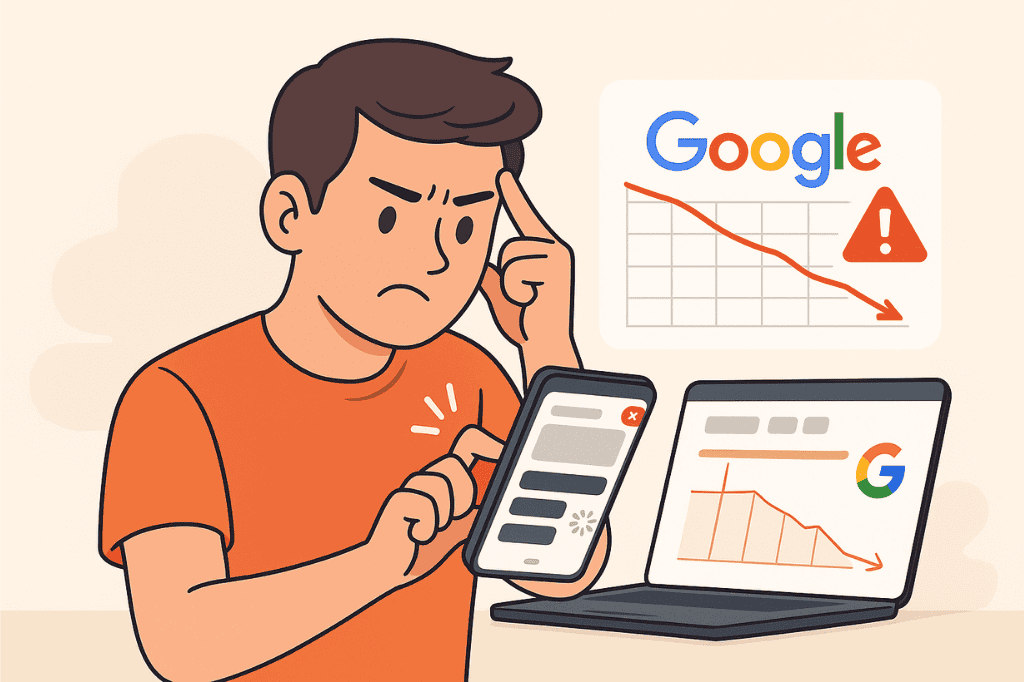
5. No online reviews strategy:
Reviews help with trust and rankings. But many business owners don’t ask for them, don’t respond, or only act when a bad one appears. and you shouldn’t act like them or you will become invisible for the infinity.
Fixing these issues doesn’t require a massive budget, just the right steps required.
Here’s how you can fix them accurately-
Optimizing Your Google Business Profile the Right Way
Your Google Business Profile (GBP) is often the first thing people see when they search for your service. It acts like your digital storefront, and in 2025, it matters more than ever.
- Start by filling out every section:
- Business name (exact and accurate)
- Address, phone number, website
- Business category and subcategories
- Opening hours (keep them updated)
- Service areas, especially if you travel to customers
Next, focus on photos. Add real images of your location, services, team, and products. Businesses with photos get more clicks and calls, it’s that simple.
Encourage customers to leave honest reviews. Don’t just wait for them to come in instead ask for them. Then reply to each review using friendly, keyword-rich responses. This shows engagement and gives Google more context.
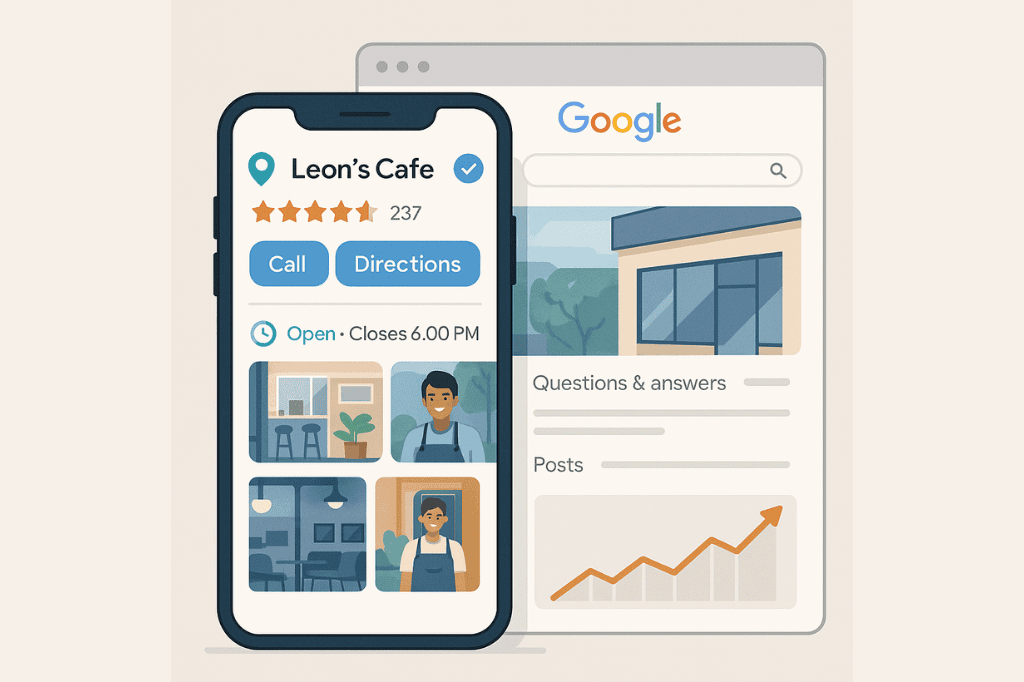
Lastly, use GBP posts to share offers, events, or updates. Think of it as social media for search.
A fully optimized GBP profile tells both customers and search engines: “We’re ready for business.”
Location Pages: How to Rank in Multiple Service Areas
If your business serves more than one town or city, you need more than a homepage. You need dedicated location pages for each service area and have to built them right way.
Each page should focus on a single area, like “Plumbing Services in Swindon” or “Hair Salon in Swindon.” Don’t just copy and paste the same content with different city names. Instead, talk about what matters in that area:
-
Mention local landmarks or neighborhoods
-
Highlight services popular in that town
-
Include local reviews or case studies
-
Add a unique call to action for each page
This helps Google see each page as truly relevant to that area. And when people search for services “near me,” you’re more likely to show up.

Location pages also help customers feel seen. They want to know you understand their area.
If you’re not sure how to create these, we’ll show you how Scaleeseo builds high-converting location pages for clients across the UK. Reach out to us or Book a free business growth call.
Find Local Keywords That Drive Buyers
Not all keywords are equal.
Especially in local SEO.
What matters isn’t just what people search, but how and where they search it.
In 2025, smart local businesses focus on intent-driven keywords, like:
-
“emergency locksmith near me”
-
“best pizza in Camden”
-
“24-hour vet in Manchester”
These phrases show clear buying intent means someone’s ready to take action.
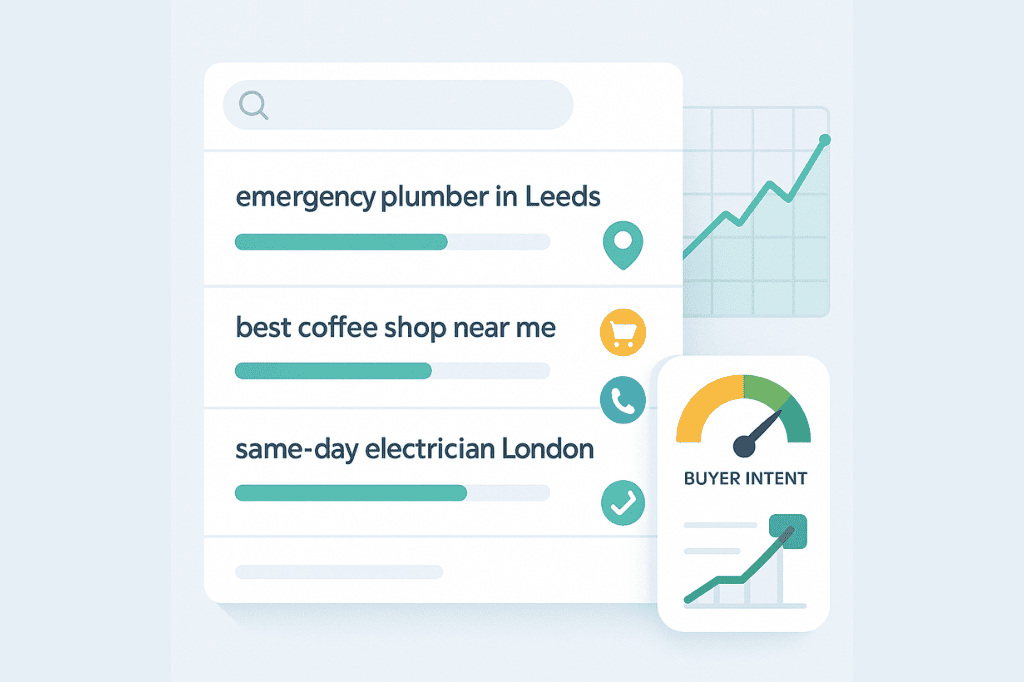
But now the questions might be, How do you find those high intent keywords?
No worries,
Here’s how to find the right keywords for your business:
-
Use tools like Google Keyword Planner, Ubersuggest, or Google Search Console
-
Look at competitor pages ranking locally
-
Pay attention to customer language in reviews and inquiries
Once you’ve got your list, use these keywords naturally in:
-
Page titles and meta descriptions
-
Headings and image alt text
-
Your Google Business Profile posts
-
Review responses and FAQs
The goal isn’t stuffing, it’s signaling by adding those terms naturally. By doing this, you’re showing both search engines and customers that you offer the right solution in the right location.
Don’t Overlook Local Citations and Consistency
Local citations are online mentions of your business’s name, address, and phone number (aka: NAP). You’ll find them in places like business directories, social media platforms, and local listings.
It may seem small, but it send strong trust signals to search engines.
But Be careful, Inconsistent citations like having different phone numbers or slightly different business names across platforms can confuse Google. And confusion leads to lower rankings.
Here’s how to strengthen your citation profile:
-
List your business on trusted directories (like Yell, FreeIndex, 192.com, and Scoot)
-
Keep your NAP details exactly the same everywhere
-
Update old or incorrect listings
-
you can take help from a tool like BrightLocal or manually track your listings in a spreadsheet
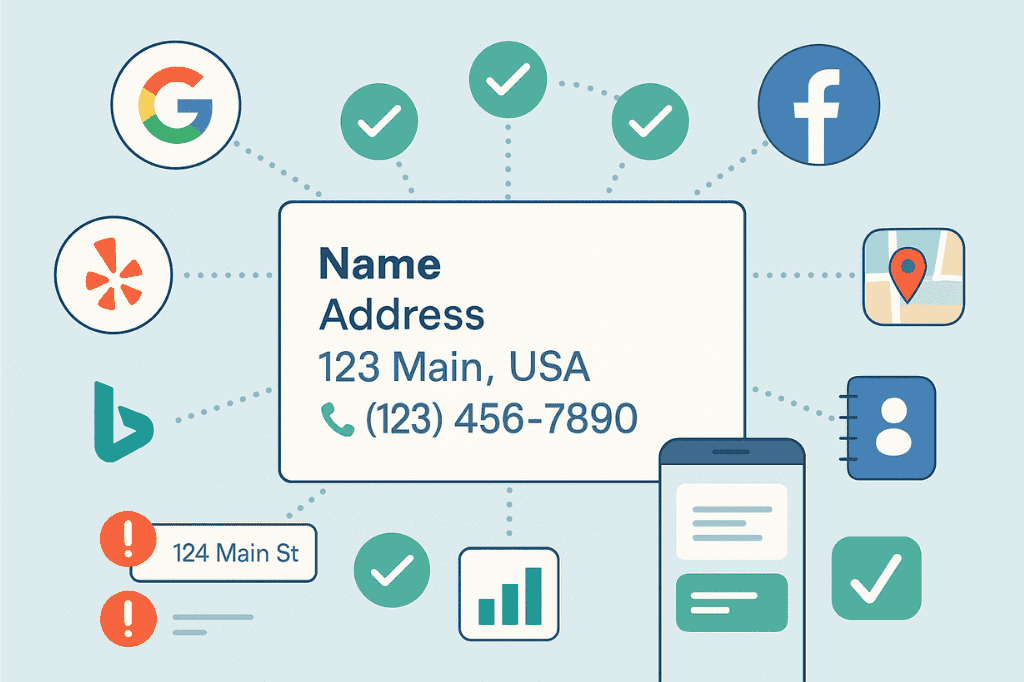
Consistency shows professionalism. And when Google sees the same business details across multiple sources, it becomes more confident in your credibility.
This is one of the simplest yet most overlooked parts of local SEO, and one of the easiest wins you can target to improve your business local visibility.
Now, let’s talk about reviews,
Why Online Reviews Are SEO Gold
Reviews do more than build trust in fact they help you rank.
In 2025, Google places heavy weight on what your customers say.
Local businesses with steady, high-quality reviews often appear higher in map results and organic listings.
But it’s not just about having lots of reviews. It’s about having:
-
Recent reviews (Google loves fresh signals)
-
Relevant keywords mentioned in them
-
Responses from the business owner
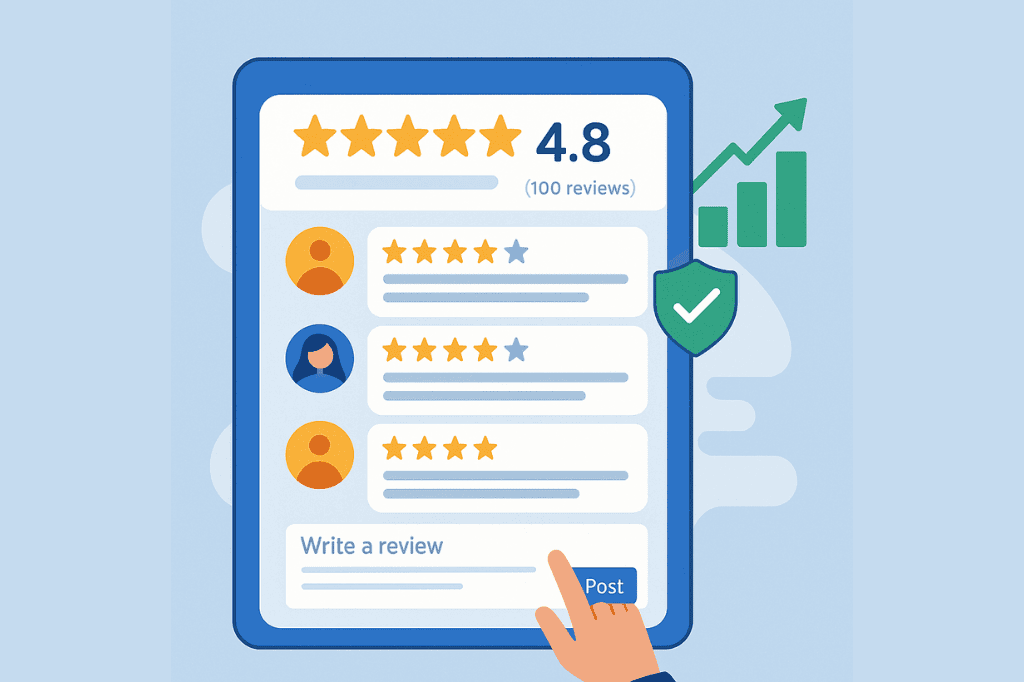
Here’s how to get more great reviews without sounding desperate:
-
Ask right after a successful sale or service
-
Send a short link via email or text
-
Use thank-you cards with QR codes
-
Make it easy, quick, and optional
And always respond faster even to the bad ones. Responding shows you care, and it gives Google more local content to index.
If you do this consistently, your reviews won’t just attract customers, it’ll boost your visibility too.
Mobile SEO for Walk-In and Map-Based Customers
Most local searches happen on phones. Whether it’s someone looking for a nearby restaurant or a plumber during an emergency, mobile is often the first touchpoint.
If your site isn’t mobile-friendly, you’re turning customers away before they even read a word.
Here’s what you need to get right:
-
Fast load time: A delay of just 2–3 seconds can make users bounce
-
Clickable buttons and phone numbers: Especially for “Call Now” or “Get Directions”
-
Responsive design: Your site should adjust to all screen sizes
-
Location features: Include embedded maps, directions, or service area tags
-
Local schema markup: Helps Google understand and display your business info in mobile search
Also, test your site using Google’s Mobile-Friendly Test tool. Small changes in layout or speed can lead to big wins in clicks, calls, and visits.

In short: If your local customers are on their phones, your business needs to meet them there quickly and clearly.
Local Content Strategy That Builds Authority
To stand out in local search, you need more than service pages. You need hyper local content that shows you’re active, trusted, and part of the community.
Google rewards relevance. So instead of generic blog posts, write content need to tied to your area, such as:
-
“Top 5 Events in Leeds This Month (And How to Get There Safely)”
-
“How We Helped a Local Shop Cut Energy Costs with PAT Testing course”
-
“Why Our Customers in Norwich Prefer Same-Day Service”
This does two things:
-
Builds trust with local readers
-
Sends clear location signals to Google
You can also add:
-
FAQs that answer location-specific questions
-
Staff spotlights or behind-the-scenes posts
-
Local case studies or before-and-after stories

And don’t forget internal linking to connect your blogs to your service or location pages.
This strengthens the overall SEO structure and helps both users and search engines find what they need.
In short, make your content useful and local because it’s a proven way to earn attention and trust.
When to DIY and When to Hire Experts For your Local Business
Not every local business owner needs to hire an SEO agency right away. Some basics like updating your Google Business Profile or adding service area pages can be done in-house. But as your business grows, so do the SEO demands.
DIY might work if:
-
You have time to learn and implement best practices
-
Your competition is low and your service area is small
-
You’re comfortable using SEO tools and updating your site regularly
But hiring experts makes sense when:
-
You’re stuck in low rankings despite your efforts
-
You want faster results without guesswork
-
You need help managing multiple locations or service areas
-
You’re spending too much time on SEO instead of running your business
That’s where a skilled team comes in. We handle every layer from technical SEO and content to local citations and GBP optimization. So you can focus on what you do best.
How Scaleeseo Helps Local Businesses Grow Online
At Scaleeseo, we don’t just run SEO checklists. We build strategies that drive real business growth.
We’ve helped local businesses rank higher, get more phone calls, and turn local searches into steady revenue.
Whether you’re a single-location shop or a multi-area service provider, we tailor our SEO efforts to your business goals.
Here’s what we do differently:
-
Local SEO Audits: We start by identifying what’s holding you back
-
Smart Keyword Targeting: We don’t chase volume — we target buyers
-
Conversion-Focused Content: Every blog, location page, and meta tag is written to rank and convert
-
Technical Fixes: From page speed to mobile usability, we handle the back-end work that improves rankings
-
Ongoing Support: SEO isn’t one-and-done, and neither are we
We don’t promise page-one overnight. We promise work that delivers and results that last.
Let’s Grow Your Local Business – With Us
You don’t need to figure it all out alone. If you’re ready to bring in more local traffic, more phone calls, and more business, we’re here to help.
At Scaleeseo, we help local business owners across the world, turning their online presence into a steady stream of leads and customers.
Whether you’re just starting or scaling up, we’ll create a plan that fits your goals and your market.
Let’s get started.
Book your free Local SEO consultation today and let’s talk about growing your business, one search at a time.



